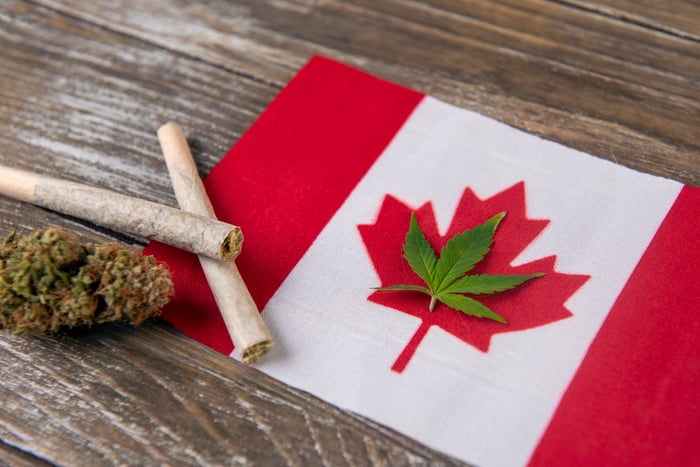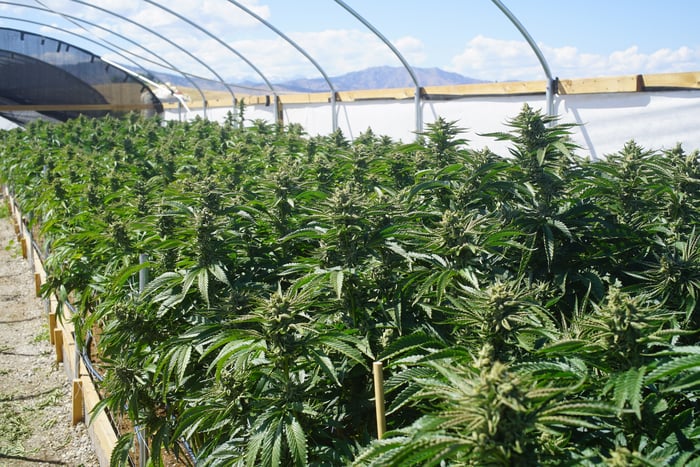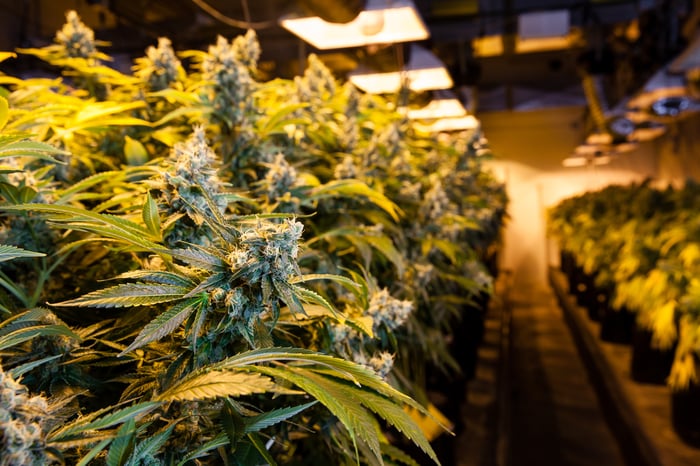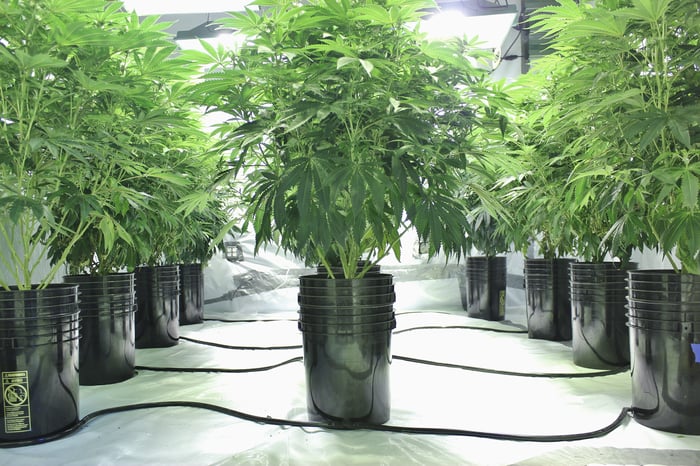Big things are happening in the marijuana industry, and Canada is currently the epicenter of the action. Last year, our neighbor to the north became the first industrialized country in the world to green-light recreational cannabis, and it's expected to generate $5 billion to $6 billion in annual sales within the next couple of years.
Of course, the ramp-up of legal weed in Canada hasn't exactly been smooth sailing. Early-stage supply chain issues, including a monstrous backlog of cultivation, processing, and sales applications at Health Canada, and a shortage of compliant packaging solutions have substantially constrained the ability of dispensaries to meet demand in the adult-use market. These supply issues are at least a couple of quarters from working themselves out, even with aggressive policy changes being made by Health Canada.
However, these supply issues aren't stopping pot stocks from doing the one thing that could minimize long-term growth concerns and provide a steady stream of cash flow -- namely, signing lucrative supply agreements with as many Canadian provinces as possible. To date, four pot stocks, two of which might be surprises, have supply deals in place with every Canadian province.

Image source: Getty Images.
Canopy Growth
Perhaps it's no surprise that the most storied of all marijuana stocks, and the one with the largest market cap, secured supply deals with all of Canada's provinces before the curtain even lifted on recreational cannabis being legal. According to Canopy Growth (CGC -3.13%), it has secured deals that total approximately 70,000 kilos of annual production.
Canopy Growth is a fairly logical choice for provincial supply given its willingness to focus on the recreational market. When examining recreational pot sales relative to medical cannabis sales, Canopy Growth had one of the strongest leanings to the adult-use market, with almost 80% of its cannabis revenue derived from recreational pot.
This is also a company that's expected to be a top-tier producer. At last check, it had more than 4.4 million square feet of cultivation space licensed by Health Canada out of a possible 5.6 million square feet. When operating at full capacity, it would not be surprising to see Canopy Growth produce more than 500,000 kilos per year, which is likely to slot it in safely as the second-largest grower in Canada.
Canopy Growth also has a lot to offer from a branding perspective. The company's Tweed brand is arguably the most well-known cannabis brand throughout Canada. Canopy's diversity of products, as well as its ability to offer numerous derivatives, including softgel capsules, oils, and infused beverages, by perhaps as soon as October, could very well be another reason it's had little issue landing lucrative long-term supply deals with Canadian provinces.

Image source: Getty Images.
Aphria
Although it's been rife with controversy of late, Aphria (APHA) was the only other pot stock to have supply agreements in place with all of Canada's provinces prior to the waving of the green flag on recreational marijuana in October 2018.
Like Canopy Growth, Aphria is a logical grower to supply much of the country given its huge expected output when operating at full capacity. The organically constructed Aphria One facility is capable of 110,000 kilos a year, while its partnered Aphria Diamond grow farm, which involves retrofitting existing greenhouses to grow cannabis instead of vegetables, should produce 140,000 kilos when licensed. Add on its acquisition of Broken Coast Cannabis, and we arrive at Aphria's 255,000 kilos of estimated annual output, which may be good enough for third-highest in Canada.
As noted, though, Aphria is shrouded in controversy following a short-seller report in December that alleged the company grossly overpaid for its Latin American assets. An independent committee review found that the price paid for these assets was within a reasonable range, but longtime CEO Vic Neufeld wound up stepping down after it was disclosed that certain directors had conflicts of interest in the acquisition. What's more, Aphria took a 50 million Canadian dollar impairment charge on the carrying value of these Latin American assets in its most recent quarter, further hurting trust in the company's management team.
Thus, while Aphria may look inexpensive and have locked in supply agreements throughout Canada, it comes with some pretty serious question marks.

Image source: Getty Images.
OrganiGram Holdings
Now for those aforementioned surprises. First, you might be shocked to learn that the only major Atlantic-based grower, OrganiGram Holdings (OGI -2.66%), locked up a supply deal with Quebec in February, the last remaining province that it didn't have a supply deal with. Despite being valued at just over $1 billion, OrganiGram has secured supply deals with all of Canada's provinces before giants like Aurora Cannabis and Cronos Group.
While it's unclear exactly how much cannabis OrganiGram will be supplying each province, what is clear is that the company is, thus far, laser focused on the recreational market and is expected to generate some of the most impressive yields in the industry.
In terms of comparing recreational sales to medical cannabis sales, OrganiGram has recently generated more than 90% of sales from the adult-use market. That's the perfect ratio if it wants to cater to the provincial market, which is struggling to keep cannabis on dispensary shelves in the early going.
With regard to yield, OrganiGram and its only grow facility in Moncton, New Brunswick, expect 113,000 kilos when fully operational across approximately 490,000 square feet. That's 231 grams per square foot, which is more than double the average projected yield per square foot in the industry. OrganiGram's focus on maximizing output while minimizing costs should work out nicely.

Image source: Getty Images.
CannTrust Holdings
The second surprise is that small-cap grower CannTrust Holdings (CNTTQ) is the fourth and final pot stock to run the gauntlet, so to speak, on securing supply deals with all of Canada's provinces. Like OrganiGram above, Quebec was the last piece of the puzzle for CannTrust, but it recently secured a letter of intent with Quebec's regulators.
Again, while it's unknown exactly how much cannabis CannTrust will be supplying on a wholesale basis to Canada's provinces, the company's sheer output potential and burgeoning focus on derivatives made it a relatively logical choice for provinces seeking product diversity and supply.
In mid-January, CannTrust received the permitting go-ahead from the town of Pelham in Ontario to construct a phase 3 expansion totaling 390,000 square feet at its flagship Niagara facility. This high-tech hydroponic grow farm will span 840,000 square feet when complete. When it's added to the smaller Vaughan campus spanning 60,000 square feet, CannTrust should yield 100,000 kilos purely from low-cost hydroponic farming.
The rest of CannTrust's output will come from outdoor growing. The company plans to acquire 200 acres of land that could grow between 100,000 kilos and 200,000 kilos of cannabis yearly. For those of you doing the math, that means 200,000 kilos to 300,000 kilos in aggregate peak production. Much of this outdoor growing will be used for extraction purposes and the creation of high-margin derivative products.
Even though supply deals alone aren't a guarantee of success for pot companies, these four certainly have a leg up on their competition.





